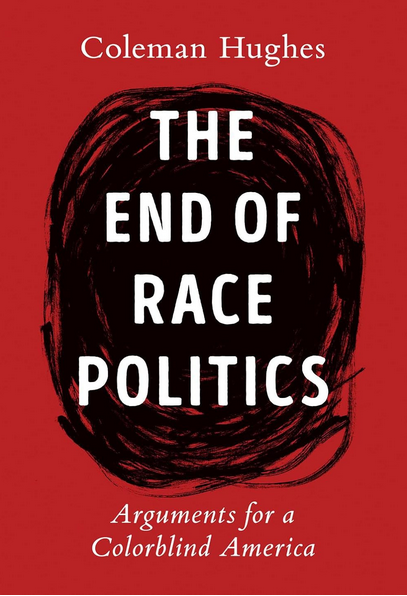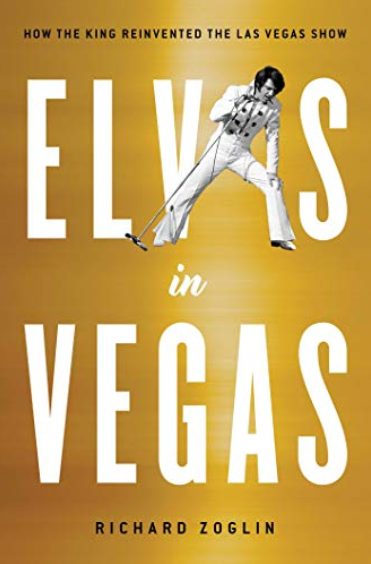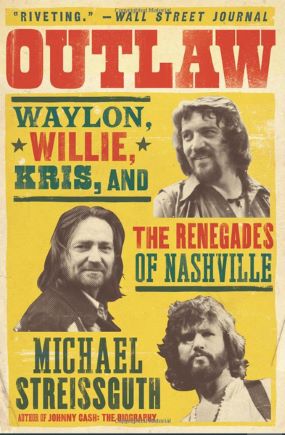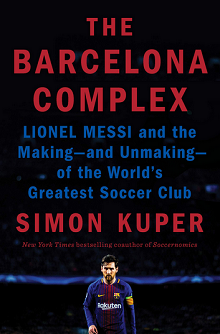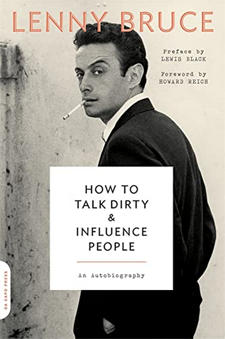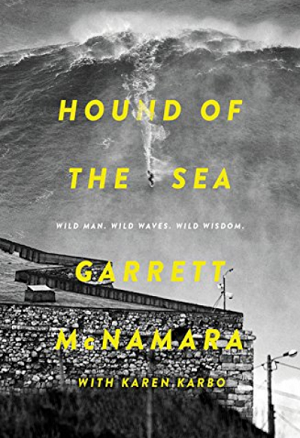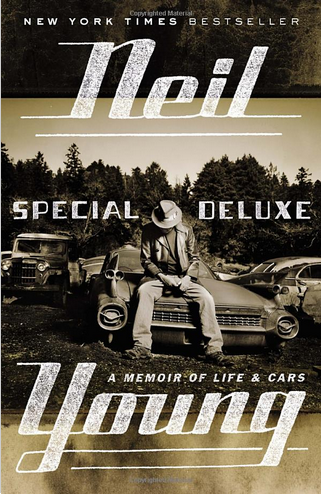Search the Blog
Categories
- Books & Reading
- Broadband Buzz
- Census
- Education & Training
- General
- Grants
- Information Resources
- Library Management
- Nebraska Center for the Book
- Nebraska Memories
- Now hiring @ your library
- Preservation
- Pretty Sweet Tech
- Programming
- Public Library Boards of Trustees
- Public Relations
- Talking Book & Braille Service (TBBS)
- Technology
- Uncategorized
- What's Up Doc / Govdocs
- Youth Services
Archives
Subscribe
Author Archives: Sam Shaw
Friday Reads: The End of Race Politics: Arguments for a Colorblind America
Reading this book conjures up thoughts about collection development. Yep, that’s right, for the handful of you that are reading this, I want to talk about collection development, on the record. Not necessarily because you might have limited knowledge of this practice (you may or may not—let’s avoid assumptions), but rather my concern is that some libraries may have forgotten the importance of having balanced library collections, or perhaps have never really believed in the practice in the first place. Coleman Hughes, for instance, presents an alternate view of race politics, taking aim at contemporary works by Ibram Kendi and Robin DiAngelo, among others espousing similar views. He doesn’t pull any punches in his criticism, starting with labeling them as “Neoracists” (to be fair, a term used by many others, including, notably, John McWhorter). We live in times where some (librarian or not) might dismiss outright the assertions of Hughes, limiting his book in library collections (or requesting it’s immediate removal) while categorizing what he has to say as blasphemy, disinformation, or applying any other ridiculous criticism. To me, it doesn’t matter if one agrees or disagrees with what Hughes (or Kendi, DiAngelo, et. al.) has to say; it’s a question of providing the public with an up to date collection of opposing viewpoints on relevant subject matters. For example: Does your library collection contain books by Kendi and Ta-Nehisi Coates, but no antithesis from someone such as Coleman Hughes, Thomas Sowell, Glenn Loury, or John McWhorter? I imagine some might provide a feeble defense to these unbalanced collection development decisions by arguing that they are (as morally superior individuals looking out for you, the uninformed, ignorant reader who is incapable of your own thought) preventing dangerous “misinformation” from being spread and consumed by you. Hey, they are looking out for your interests, or protecting you, and for that reason, you should get off their case. Maybe even thank them. But is that your role as librarian? To be the arbiter of The Truth, one way or another? Ultimate decider of what is accurate or inaccurate? Or is it to offer a robust set of resources, presenting point and counter point, to individuals and the community at large so that they can make their own decisions? I’d argue the latter. Over the past few years, we’ve heard various hyper-ventilations about protecting the public from dangerous misinformation, formation of government ministries of truth, and the antidote to this the library’s promotion of censorship (e.g. casual exclusion of certain viewpoints, de-selection of materials, or non-selection in the first place) to achieve that end. Of course, come to find out, those marginalized as dangerous misinformation spreaders turned out later on to have a track record that is equal to or greater than Larry Holmes (69-6, 44 by KO). Sometimes, this nonsensical censorship is sold under the guise of “information literacy”. The perplexing part is that many seem perfectly OK with this. In response, the Supreme Court opinion in U.S. v. Alvarez comes to mind:
“Our constitutional tradition stands against the idea that we need Oceania’s Ministry of Truth . . . And suppression of speech by the government can make exposure of falsity more difficult, not less so. Society has the right and civic duty to engage in open, dynamic, rational discourse.”
Which brings me to my second rant about balanced collections and that, my friend, is book displays. Don’t get me wrong, I’m all for book displays in general, and the promotion of books and other items in the collection, strategically placed towards the checkout aisles like the Swiss Cake Rolls and Snowballs at the grocery store, as an effective strategy for suggestive selling and increasing your stats. But we should be careful about what we decide to promote and by exclusion, not promote. The book display shouldn’t be the librarian’s personal exhibition of what they think patrons should be reading (and by exclusion from the exhibit, not reading). Nor should it be the librarian’s opportunity to promote his or her own social or political causes at the expense of presenting any opposing viewpoints. For this reason, I believe the display should be somewhat generic in nature. All too often, they aren’t. They may be well intended, to correspond to a certain monthly event or holiday, for instance. Seems innocuous on the surface. But the problem with this is the display promotes those groups included in that monthly event and has the effect of excluding all others. Let’s cut to the chase, and use as an example the plethora of history/heritage months that have been designated, since we are talking about race under the blanket of this book on race relations by Coleman Hughes. Does your library have a display for Black History Month? If so, does it display for all the other history or heritage months to cover all members of your community? What about Asian History Month (May)? Hispanic (September)? Native Americans (November)? Let’s not forget the Irish (March). Arab-Americans (April)? Of course, there are many groups absent from these lists, and Jewish history doesn’t get it’s own billing (sharing May with the Asians). Why is that? Do all these history months divide the population by pointing out our differences (one of the key points Hughes makes), or bring them together? What if you are French Canadian? German? Italian? Welsh? Norwegian? Swedish? Slovakian? Or a member of virtually any other conceivable ethnic group not mentioned here? Does the absence of a book display for your group mean the library seeks to exclude you or send the message that those other groups matter, but you don’t? Perhaps the library should focus its attention in a broad way on American history, and then include a wide range of authors representing various viewpoints on various subjects. Maybe you agree (as I do) with Morgan Freeman, who concluded that Black History Month (and all the others, by applying the same logic) is a ridiculous farce:
“You’re going to relegate my history to a month? … Black history is American history. [Mike Wallace]: How are we going to get rid of racism and … [Morgan Freeman] Stop talking about it. I’m going to stop calling you a white man. And I’m going to ask you to stop calling me a black man. I know you as Mike Wallace. You know me as Morgan Freeman.”
Now a few words about Hughes and The End of Race Politics in particular. It would be easy to take the approach that Hughes speaks the truth, thank him for having the audacity to call out the Neoracists, elevate his prescription for a colorblind society, and discount (or outright dismiss) people like Ibram (“the only remedy to past discrimination is present discrimination. The only remedy to present discrimination is future discrimination”) Kendi as race hustlers or race grifters. Of course, such action would violate the deeply held free exchange of thought principles enunciated throughout today’s write up. The takeaway is that ALL of these resources should be held and equally promoted in the library, point and counter point, for the reader seeking to understand and develop their own views on race and what might ultimately be the prescription for a better America. And, since almost all of these authors seem to claim succession to the legacy of MLK Jr., perhaps someone seeking knowledge on these subjects should read his books as well (and they should be stocked in the library collection), including the last one, Where Do We Go From Here: Chaos or Community.
Hughes, Coleman. The End of Race Politics: Arguments for a Colorblind America. Thesis. 2024.
Friday Reads: Elvis in Vegas: How the King Reinvented the Las Vegas Show
I miss the Las Vegas of old. The endless submersion in Kitch (perhaps only bested by the highly recommended House on the Rock), cheap eats and drinks, low stakes table games, cigarillo smoke, and copious amounts of prime opportunities for people watching. Much of this existed historically, or at least to a greater extent by comparison, Downtown. I remember the draw to Downtown, before the gaudy “Fremont Street Experience” was installed in 1995. Less walking for sure, not to mention a much better value. A place where you could traverse across 4 or 5 casinos in a matter of just a few minutes. Where you could play 25 cent craps at the Golden Gate or $1 tables at the Four Queens, California, Las Vegas Club, Union Plaza, or the Horseshoe. If you were highbrow, you went to the $5 tables at the Golden Nugget. The dice go cold? Pick up your cocktail and head next door. You had options. For hungry gamblers, a trip over to the El Cortez or Lady Luck always offered excellent value, just off the main drag, but it was always advisable on the walk back (especially at night), to never, under no circumstances ever, stop. Always keep moving. These days, unfortunately, on the main drag downtown, you have hustlers in outlandish costumes (or virtually no costume at all) hassling you every ten seconds under that Fremont Street canopy that reeks of Commercialism.
Out on the strip, you used to have classics such as the Aladdin, Dunes, Riviera, Sands, Sahara, and while the Tropicana is still there (technically), the Moai are unfortunately long gone. The Moai most likely were too large to move at 35 feet tall, made outta solid concrete, and weighing 300,000 pounds each (they should’ve just left them there). While the Aku Aku restaurant in Las Vegas closed before my time, I did visit the Stardust on numerous occasions before it was imploded in 2007. Nothing would beat a cocktail stop at Slots-A-Fun when strolling the strip on hot summer days. Always ice cold and always just 75 cents, purchased from the guy standing across from the open door, insulated by the blaring casino air conditioning. Now we have the godawful Margarita by the Yard, at the low low price of (roughly) $35. The quantity may be there, but the value and quality sure ain’t. The authorities did keep one Aku Aku Moai, from the restaurant at the Stardust, (smaller than the ones at the Tropicana) moving it to Sunset Park, so there is that I suppose. Some of the local old timers may remember the Aku Aku lounge in Lincoln, inside the Villager Motel on O Street. Swank at a level only matched by its obvious equal, The Brothers Johnson. Unfortunately, like almost every other good thing around, the establishment tore down the Villager. The Tropicana will soon be demolished to make way for a baseball stadium, as many other icons have likewise succumbed to destruction. Anti-depressants were undoubtedly popped by any rational person after the announcement that the Mirage was sold and its iconic volcano will (eventually) be torn out to make way for a guitar shaped hotel (the property is now operated by Hard Rock International). What is the matter with these people? We should be discussing restoration of these gems to what they once were, instead of demolishing them in favor of something “new” that lacks any ounce of character. While I’m on the subject, I’d add that in almost all cases, demo and rebuild is more expensive than renovate and restore. However, the architects, designers, and consultants (and the politicians being greased by them) don’t make as much money taking that train, which is why the conductors ain’t selling it.
This book is more than merely the story of the revival of Elvis Presley’s career by virtue of his 636 sold-out shows at the International Hotel in Las Vegas. It tells a much broader story of the other performers and the history of those performances in the city. The set-up leading to the resurgence of Elvis is a worthwhile read. Yes, there is much focus on the Rat Pack and other Vegas essentials such as Tom Jones, Wayne Newton, Liberace, and Don Rickles (just to name a few), as well as the numerous all night long lounge acts. Takeaways: Most were great performers, but Frank Sinatra was a tyrant of legendary magnitude, directing his outbursts to almost all, but especially Sammy. The writing in this book is filled with all sorts of nuggets. As evidence, describing the comeback of Elvis, and the success of his first show, Zoglin summarizes:
“The show lasted an hour and fifteen minutes, and Elvis worked himself to a frazzle: pacing the stage like a panther, crouching, lunging, leaping, doing karate kicks and punches. He was audibly huffing and puffing after just a few minutes. He gulped water and Gatorade and mopped his sweat with towels handed to him by Charlie Hodge, or handkerchiefs and napkins tossed onstage by women in the audience.”
And, the downfall:
“His performances first began to be affected, by most accounts, during his August 1971 engagement. Elvis looked puffy and seemed listless onstage. His sets were rarely longer than forty-five minutes, and filled with so many fits and starts and distracting karate displays that some audience members actually walked out.”
Overall, Zoglin’s book is a formidable history of entertainment in the city of Las Vegas. Don’t be fooled by the title, it only partially describes the comeback (and downfall) of Elvis. In reality, it’s a much broader history of showbiz in Las Vegas, and the longing for those good ol’ days.
Zoglin, Richard. Elvis in Vegas. Simon & Shuster, 2019.
Friday Reads: The Wolf of Wall Street
The Wolf of Wall Street, written by Jordan Belfort, a/k/a the Wolf, focuses primarily on his time running the Long Island, NY brokerage house Stratton Oakmont. His story involves numerous crimes centered around various pump and dump schemes, securities fraud, and money laundering. The book came about when he was doing his time (of course Belfort was caught) and his cellmate encouraged him to write a book due to gut busting laughter when hearing his stories. His cellmate was none other than Tommy Chong (sentenced for selling paraphernalia online via his company, Nice Dreams).
Yes, this guy wasn’t a saint. Yes, he defrauded his investors, lied to the people around him, did copious amounts of drugs, committed multiple crimes, and didn’t treat his family well. But, you know what, the stories are entertaining, and in some sense the reader feels like they want to root for him. In his favor and against those he is maneuvering around in his business, and against the feds. To me, it feels much the same way one roots for Tony Soprano (yes, overall he’s a bad individual that does some bad things, but something about him is likeable). Even if you’ve seen the movie adaptation (2013, directed by Martin Scorsese), the book is recommend for the in-depth look into (as Belfort puts it) the lives of The Rich and Dysfunctional. It’s an easy read, and should be on the list of every low brow reader.
Belfort, Jordan. The Wolf of Wall Street. Bantam. 2008.
Friday Reads: Chaos: Charles Manson, the CIA, and the Secret History of the Sixties
The subject matter in Chaos explores many of the general goings on in the 60’s and 70’s, and a few specific ones. Tom O’Neill begins this journey by examining (with a fresh lens independent of Vincent Bugliosi’s Helter Skelter), the Mason murders and leads to the CIA, government cover-ups, frauds, and numerous examples of “this doesn’t look right”. It would be easy to dismiss all of what O’Neill writes about as conspiracy. I’m certain that some will, without even reading his reporting, but doing so would be a closed minded disservice to understanding important facets of what he explores. Speaking of conspiracy, we live in times where discourse, discussion, and debate are largely dead. Instead, we have labels and zero substance – quick one-liners (often labels) that grab attention and fit our societal mentality of the short or non-existent attention span of citizens. This is consistent with the omnipresent cell phone mentality – use of the phone between sets at the gym, use of the phone during in-person meetings whilst someone else is speaking, and even the use of the phone between writing sentences. It should be noted that the book’s title – Chaos, is a reference to the CIA’s domestic espionage program from 1967 to 1974, encompassing numerous government activities.
Chaos starts with this fresh look at the Manson murders, challenging Bugliosi’s Helter Skelter theories. While O’Neill doesn’t purport to have all the answers or a smoking gun, he illustrates, often from public records and interviews, many inconsistencies in the official narratives. Whether related or unrelated, O’Neill uncovers facets of the CIA’s involvement in a number of things that oddly intersect the Manson players, notably its CHAOS and MK-ULTRA programs. Undoubtedly, the CIA was running in the same circles as the Manson family (as was Hollywood), and O’Neill aptly sums up his conclusion that things did not smell right:
“So when I plunged into their stories with Manson and found evidence of serial dishonesty—again, often connected to federal law enforcement and intelligence agencies—I had to ask myself if I was crazy to be doing all of this.”
This book is relatively long, at 528 pages. O’Neill’s contract was cancelled by the original publisher and sustained threats of lawsuits and smears from Bugliosi, but eventually published after O’Neill’s long period of research. An apt summation can be found in O’Neill’s Epilogue:
“My goal isn’t to say what did happen—it’s to prove that the official story didn’t.”
I imagine that since so much time has elapsed between the events described by O’Neill in Chaos and the current day, much of what he writes will be largely ignored. Likely, had this book been written closer to the Manson murders, O’Neill would probably be smeared under the umbrella of something like the Martha Mitchell effect. Doing so would largely be a mistake that seeks to erase important facets of American history, albeit unflattering to law enforcement and the CIA.
O’Neill, Tom and Piepenbring, Dan. CHAOS: Charles Manson, the CIA, and the Secret History of the Sixties. New York, Little, Brown and Company. 2019.
Friday Reads: Outlaw: Waylon, Willie, Kris, and the Renegades of Nashville
The year was 1986, and I had just finished the front 9 at Holmes Park Golf Club. Fletcher and I were headed towards the clubhouse for a quick snack, as time was of the essence because we had tickets to the Hall and Oates concert that night at the Bob Devaney Sports Center. As we entered the clubhouse, a fellow golfer we knew, acting somewhat excited, told us that “Kris Kristofferson is in the can”. Both Fletcher and I, simultaneously, replied with “Bull”, but waited patiently and sure enough in about 3 minutes, Kristofferson himself emerged from the can. He sashayed outside and picked up his golf bag, which seemed to be larger than he was, but he had no problem carrying it. We said no words to Kristofferson that day, who was in Lincoln at the time filming the TV mini-series called Amerika (about a Soviet takeover of the U.S.), but certainly now regret that decision to remain silent. If we knew then what we know now, undoubtedly it would have went down quite differently on that day.
Dad was a diehard country music fan, especially outlaw country, and even though the year before the brush with Kristofferson he hauled us against our will to the County Music Hall of Fame in Nashville, he never (as far as I recall) spoke about Kristofferson or his songwriting prowess. Dad was all Johnny Cash, George Jones, and some Waylon. He didn’t like Willie Nelson because of his ponytails, although after Dad died I found Willie’s Red Headed Stranger in his album collection, and I’ve enjoyed it many times. I found no Kristofferson, but did find copious amounts of Merle, Waylon, and Tammy (in addition to those previously mentioned).
Today’s write-up is about the book Outlaw: Waylon, Willie, Kris, and the Renegades of Nashville, by Michael Streissguth. Outlaw describes the history of these three country music musicians (including Cash, the members of the super group The Highwaymen), with Nashville as the central focal point. In 1986, I had no idea of the depth of Kristofferson’s writing aptitude, but now have come to realize and acknowledge it with the utmost of respect. Kristofferson’s catalog includes Bobby McGee, Help Me Make it Through the Night, The Taker, Sunday Morning Coming Down, Loving Her Was Easier, For the Good Times, Jesus Was a Capricorn, and many others. If I had a do-over of that day in 1986, I would have thanked Kris and expressed my appreciation for his work. Outlaw also describes the logistics of the rise and intersection of Willie and Waylon’s work together, in and out between Nashville and Texas, and the rise of The Johnny Cash Show. The book also describes the battles faced by the musicians, mostly the addictions of Waylon and Cash (pills), and Kristofferson’s battles with alcohol. Waylon would often go on binges where he would not sleep for a week, but unlike George Jones (who also had legendary binges), rarely missed shows. While separate individual biographies on all the major players here are highly recommended for the more detailed narratives, Outlaw serves its purpose as a short dip into the zero entry pool. In tandem, for you youngsters who are starting to collect vinyl, if available snatch up copies of Jesus Was a Capricorn or The Silver Tongued Devil and I. You shouldn’t be disappointed, and they won’t cost a fortune.
Streissguth, Michael. Outlaw: Waylon, Willie, Kris, and the Renegades of Nashville. It Books. 2014.
2022 Public Library Survey Data are Now Available
 The 2022 FY public library survey data are now available on the NLC website. This is preliminary data (meaning that it has not yet been certified by IMLS) so keep in mind that it is subject to change. Thanks to all of you who submitted your statistics. Historical data (back to 1999) are also available on our website. The next survey cycle begins in November, but you should be collecting those statistics now. If you are a new library director, check out the Bibliostat guide.
The 2022 FY public library survey data are now available on the NLC website. This is preliminary data (meaning that it has not yet been certified by IMLS) so keep in mind that it is subject to change. Thanks to all of you who submitted your statistics. Historical data (back to 1999) are also available on our website. The next survey cycle begins in November, but you should be collecting those statistics now. If you are a new library director, check out the Bibliostat guide.
Friday Reads: The Barcelona Complex: Lionel Messi and the the Making – and Unmaking – of the World’s Greatest Soccer Club
It seems appropriate, off the buzz of this year’s World Cup, for a focus on either soccer (if you accept the American term) or football (if you live in the rest of the world). The World Cup saw many exciting games, and the consensus is deciding them via penalty kicks seems a bit arbitrary, but in the spirit of history, tradition, and nothing to offer as a better alternative, let’s accept the practice to determine a victor. Of course, the penalties can be exciting also, and the game cannot go on forever in extra time. As for the U.S. Men’s National Team (or USMNT), they certainly have some talented players, but the coaching needs a major overhaul. Two things of note on a long laundry list of items: (1) If you are in charge, don’t hire your brother. Even if you think your brother is highly qualified. Find someone else. (2) If you are said brother, and have conversations with players in the locker room, don’t go to reporters or others and disclose said conversations. Keep them within the team. The players will have respect for you for such professionalism, and you will earn much needed trust.
But today’s write-up isn’t about the World Cup, or the USMNT. It’s about FC (football club) Barcelona, aka “Barca”, in this well written narrative from Simon Kuper, entitled The Barcelona Complex: Lionel Messi and the Making—and Unmaking—of the World’s Greatest Soccer Club. One might be tempted to think that this book is about one of the greatest footballers of all time, Lionel Messi, but Messi’s rise throughout the Barca system is only a minor part of this story. The Barca club (which also focuses on sports besides just soccer), was founded in 1899, and is one of the highest value sports clubs and one of the richest football clubs in terms of revenue (it’s the expenses that might be the issue). To illustrate, Barca exceeded $1B in revenue in 2018. By comparison (believe it or not), in 2018 the highest revenue of an NFL team was the Dallas Cowboys, at $800M. Unlike the Cowboys, Barca posted a loss in that year. But, who really gives a rap about financial capabilities, it’s about winning games. A large part of the story of the rise of the Barca club has to do with its system of bringing young players in, as did Messi at age 13 (he is from central Argentina), and developing them within the Barca program.
The Barca story in this book takes place largely with the introduction of Dutch player/manager/coach Johan Cruyff, who had a long history in the sport, and was traded to Barca in 1973 as a player. Cruyff brought to Barca the Dutch concept of Total Football, where every player on the team (sans goalkeeper) is interchangeable. In other words, fluidity. Defender can move to attacker, and another player covers the open position left when the defender moves upfield. After Cruyff’s retirement from playing and various coaching gigs, he returned to FC Barcelona for the 1988-89 season as manager. Throughout his time as coach, he managed to win 11 trophies, only surpassed by one of his star players (and Barca coach from 2007-2012), Pep Guardiola (15 trophies).
Guardiola is a good example of the system of Barca success, joining the Barcelona youth academy (La Masia) at the age of 13 (same age as Messi), and climbing up to through the ranks and developing his talents. The 2008-09 FC Barcelona team under Guardiola (as manager) is considered one of the best ever, with many players coming from the La Masia youth program, notably Messi, Xavi, Andres Iniesta, and Sergio Busquets.
But, as with practically any ascent, there usually is a descent, and Kuper describes the fall of Barca with detail that leaves the reader with sadness. There isn’t one event to point to the financial ruin of the club, but rather a series of bad decisions and bad luck. COVID responses that left stadiums empty certainly didn’t help. All in all, Kuper’s effort here is coherent, easy to follow, and engaging.
Kuper, Simon. The Barcelona Complex: Lionel Messi and the Making—and Unmaking—of the World’s Greatest Soccer Club. Penguin. 2021.
Friday Reads: How to Talk Dirty and Influence People
“All great truths begin as blasphemies.”
–George Bernard Shaw
“Powerful people and popular ideas don’t need First Amendment protections; marginalized people and unpopular ideas do.”
–Nadine Strossen, former ACLU president (1991-2008), Senior Fellow, FIRE
During a time where free speech assaults are now taking place on behalf of both the political right and the left (nothing new to see here, folks), it’s interesting to take a look at this classic autobiography from Lenny Bruce. How to Talk Dirty & Influence People is a take on Dale Carnegie’s How to Win Friends & Influence People, and describes the life of Bruce from his childhood up to the time of his premature death at the age of 40. Born in Mineola, NY, Bruce’s parents divorced when he was 10, and during his childhood he spent time living and working on a farm in Wantagh, NY. Bruce joined the Navy at the age of 16 in 1942, serving in WW2. After appearing in drag for a comedy bit, he convinced his CO that he had homosexual urges and received an honorable discharge. The Max Klinger character from M*A*S*H was based on Bruce. After discharge, he went on to develop his stream of consciousness comedy routines and worked as an MC in Jazz clubs. His routines often focused on themes of race relations, organized religion, and criticism of “the establishment”. Certainly, in today’s world, most of his bits would offend damn near everyone, and there likely would be numerous calls to ban or censor him. This in fact was the case with Brandeis University, which now hosts Bruce’s audio files. Brandeis University is named after former Supreme Court Justice Louis Brandeis, champion of free speech and advocate of counter speech:
“If there be time to expose through discussion, the falsehoods and fallacies, to avert the evil by the processes of education, the remedy to be applied is more speech, not enforced silence.”
This notion seems to be forgotten or kicked to the curb in today’s world. After the audio files came in the possession of Brandeis University, Michael Weller, former graduate of Brandeis and playwright, wrote a play based on Bruce’s work, examining the ideas of free speech. Outrage over the content of the play quickly ensued, and the University promptly cancelled it. Oh, the irony. College campuses are now replete with multiple trigger warnings on practically everything, self-censorship among students for fear of repercussions, and frequent disruptions and outbursts directed at speakers who are disagreeable. They are no longer the bastions of free speech, thought, healthy debate, and exchange of ideas they once were. As Penn Jillette says:
“If college is so comfortable and safe — I’m glad I’m not there. Who wants comfortable? Who wants safe? This old piece of carny trash still wants to be pushed and challenged, and I’ve proved I can do that without college. And it’s a lot cheaper than Brandeis.”
How to Talk Dirty and Influence People also describes Bruce’s marriage to burlesque dancer Honey Harlow, and the two obscenity trials that ultimately broke him (physically, emotionally, and financially). Plagued by legal troubles relating to his drug use and financial scams (he dressed as a priest and solicited donations for a “leper colony in British Guyana”), he was ultimately charged with obscenity in (of all places) San Francisco (acquitted), Chicago (convicted but later overturned by the Illinois Supreme Court), and New York (convicted but later overturned by the New York Court of Appeals). Bruce died while the NY appeal was in process.
The book is an interesting incursion into Bruce’s life, and while the title mentions talking dirty, there’s not much of it in this book. A few tidbits of his routines and trials, but it’s mostly about his life and not his comedy acts.
Bruce, Lenny. How to Talk Dirty and Influence People: An Autobiography. Da Capo Press, Reprint edition. 2016.
Friday Reads: Hound of the Sea: Wild Man. Wild Waves. Wild Wisdom.
NOTE: I wrote this draft in 2017, and shelved it. With the recent (2021) release of the HBO documentary, 100 Foot Wave, I’ve revived it.
There aren’t a lot of books written about surfers, and certainly not a lot of books about surfers in my local library. Some of the books are clearly written primarily by the co-authors, and come across as literary braggadocios that are mostly turn-offs. At the least, they run counter to a more modest surfer code. So after starting but not finishing a couple of these, I then picked up Hound of the Sea: Wild Man. Wild Waves. Wild Wisdom, written by big wave surfer Garrett McNamara (GMac) and Karen Karbo. It is a worthy effort, and only a little bit of braggadocio, coming across as a seemingly honest portrayal of GMac’s childhood (which is interesting even without the surfing), rise among the surfing circuits, and his eventual record setting big wave rides.
I had originally wanted something about surfing legend Kelly Slater, arguably the most dominant athlete in his sport, or even any sport, as illustrated by this fantastic infographic. Some facts worth extrication: GOAT Slater has won more world titles than any athlete in any major sport, holds the record for being both the youngest and oldest surfer to win a title (20 and 40), and Kelly has won more titles than the next 3 surfers combined. I also found Slater’s clean living lifestyle of particular interest. But, my public library only had a couple of kid’s books about Mr. Kelly, so I turned to the big wave surfers. Big wave surfing is of interest in its own right, whereby the surfer is towed by a jet ski into waves that are at least 20 feet high, and often much larger. GMac held the world record for largest wave surfed (subsequently eclipsed since I wrote this in 2017), and while the images and video in the aforementioned link are impressive, the size of these waves is somewhat relative. Not to diminish the accomplishment, as it is truly impressive, but relative in the sense that many other big wave surfers have feats that are just as impressive due to a differing set of factors (e.g. barrels, reefs, etc.)
Where this biography succeeds is in telling the story of GMac’s childhood, relationship with his family and fellow surfer brother (Liam McNamara), the surf culture in Hawai’i (GMac settled on the North Shore of Oahu), and his passion for the sport and culture. It fails in that, while not outright braggadocios, it does seem like self-promotion and certainly at times like fortune cookie philosophy.
McNamara, Garrett and Karbo, Karen. Hound of the Sea: Wild Man. Wild Waves. Wild Wisdom. New York: Harper Wave. 2016.
Friday Reads: Woke Up This Morning: The Definitive Oral History of the Sopranos
There are very few guys (even the pacifists), if they are really being honest with themselves, who would disagree with the notion that at least sometimes they think or wish they could handle disputes like they do on The Sopranos. Very few. And by stating this reality, I’m not saying that those individuals actually would; I’m just saying they wish they could. Argument with some Putz at the store? Traffic road rage? Disagreement at work? Who doesn’t daydream about handling such disputes in the same fashion that Furio Giunta would? There are also other examples besides the “Furio way” that an average Joe might imagine he could handle conflict resolution, of course. Cliff Booth from Once Upon a Time in Hollywood most certainly comes to mind as such a role model. The point is not the ultra-violent acts, but rather the calmness and confidence that accompanies the action. Now, enough of this tangent, let’s get to the book.
Many of you may have at least heard of Talking Sopranos, a podcast started by actors Michael Imperioli (Christopher Moltisanti) and Steve Shirripa (Bobby Baccalieri), and this book (Woke Up This Morning) is basically the condensed highlights version of the podcast. If you don’t want to take the time to wade through each of the podcasts, I’d recommend this book. Easy to read and entertaining. Frequent guests on the podcast include the series actors, writers, set designers, and others that worked on the show’s production. Some quick highlights:
- Steve Shirripa is not nearly as big as Bobby Baccalieri. He wore a fat suit for most episodes, and during the show was actually about the same size as James Gandolfini (Tony Soprano). Around 230 pounds. Ginny Sack (played by Denise Borino-Quinn) also wore such a suit.
- Furio, played by Federico Castelluccio, while born in Napes, Italy, grew up in Patterson, NJ (since he was 3).
- Tony Sirico (Paulie “Walnuts” Gualtieri) is shockingly similar in real life to the character he played. When an episode was set to take place in Paulie’s apartment, the directors went to Tony’s actual apartment, then re-created it for the show.
- The episode “A Don Doesn’t Wear Shorts” was written after James Gandolfini received a phone call on his cell phone from an unknown number, and the caller said, mysteriously, “A Don never wears shorts”.
- Matthew Weiner wrote for The Sopranos from 2004-2007, before Mad Men.
I intend to watch some of these podcasts at a future date. The book (and likely the podcast) sometimes comes across as highbrow back patting about this and that (actors and their “art”); however, overall there is many interesting things to be learned by this behind the scenes book and corresponding podcasts.
Finally, for the record, I’m disappointed by David Chase using The Sopranos theme song, and actors Jamie-Lynn Sigler (Meadow Soprano) and Robert Iler (AJ Soprano) to peddle on behalf of Chevrolet. Watch the show (or re-watch it), not the commercial. And to David Chase: You don’t need the money, so why would you do it? To summarize this, I must quote Tom Waits (substitute “song” for “show” in the passage below):
“It’s no wonder a corporation would want to hitch a ride on the spell these songs cast and encourage you to buy soft drinks, underwear or automobiles while you’re in the trance. Artists who take money for ads poison and pervert their songs. It reduces them to the level of a jingle, a word that describes the sound of change in your pocket, which is what your songs become. Remember, when you sell your songs for commercials, you are selling your audience as well.
When I was a kid, if I saw an artist I admired doing a commercial, I’d think, “Too bad, he must really need the money.” But now it’s so pervasive. It’s a virus. Artists are lining up to do ads. The money and exposure are too tantalizing for most artists to decline. Corporations are hoping to hijack a culture’s memories for their product. They want an artist’s audience, credibility, good will and all the energy the songs have gathered as well as given over the years. They suck the life and meaning from the songs and impregnate them with promises of a better life with their product.”
Imperioli, Michael and Shirripa, Steve. Woke Up This Morning: The Definitive Oral History of the Sopranos. William Morrow, 2021.
Data About Library Fines
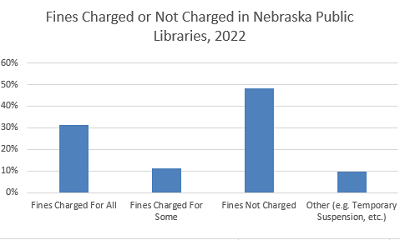
Recently, we sent a short and sweet survey to public libraries asking if fines are collected for overdue items. We received 189 responses to the survey. The results of the basic question are reflected in the chart on the right-hand side. 31% charge fines for everything that is overdue, 11% charge fines for some items or borrower age groups, and 48% don’t charge any fines. The “other” category is a bit more complicated, as these libraries reported things like temporary suspension of fines (e.g. during COVID), or amnesty days (e.g. Fine Free Fridays), or fine for the problem patron who is chronically late.
Likely, we will continue to collect these data. Eventually, fines data for individual libraries will be available on our website, as libraries may want to compare to their neighbors or peers. If you didn’t submit a survey, please contact me and I will get your data added.
If you are reviewing your fine policy, here are some links that might be helpful:
NLA Third Thursday Chat: “Going Fine Free: How we did it (and how you can too!) Recording
Friday Reads: The Sneetches
Written in 1961 (with a variant early edition published by Redbook magazine in 1953), this book contains The Sneetches and, well, other stories (The Zax, Too Many Daves, and What Was I Scared Of?). Add The Sneetches to the list of Dr. Seuss material that provides a valuable life lesson that today’s society has completely discarded or forgotten. It is by far the highlight of this collection. A classic story of us v.s. them, diversity, and tolerance, The Sneetches further expands on these notions with the addition of a capitalistic villain who takes advantage of and pits the star bellied Sneetches against their non-starred counterparts. The parallels to the world we live in today are uncanny. The Zax expands on The Sneetches and provides a lesson about stubbornness, as a north travelling Zax meets a south travelling Zax, and both refuse to move out of the way of the other one. Too Many Daves tells the story, of well, a lady who named all of her kids Dave (all 23 of them), and, you guessed it, regrets her decision. Finally, What Was I Scared Of? tells the story of a young guy who is scared of a pair of pants (who wouldn’t be scared of a talking pair of pants?), but in this case, the pants are just as scared – of the scared guy. A classic example of perception. Many of the books published by Seuss ultimately circle back to lessons of differing viewpoints, open-mindedness, and acceptance, and The Sneetches is no different.
Seuss, Dr. The Sneetches and Other Stories. New York: Random House. 1961.
Friday Reads: Post Office
Charles Bukowski was a lowbrow writer. On the one hand, some can certainly relate to his pessimistic and unpretentious philosophies of life, while others surely look upon him with disdain. The thing is, he probably would not have cared either way. Perhaps he would have even relished in the thought that someone looked upon him with disdain, as this was often the case in his writing career. Frequently, he read his poetry in various settings (frequently college campuses), had too much to drink, and then arguments with those attending often ensued or the reading quickly devolved into chaos. A long time alcoholic, who for years lived on skid row in L.A., Post Office recounts his years with the agency, first as a substitute mail carrier, then after a gap in service, a full-time postal employee. Overall, Bukowski worked for the Postal Service for 14 years. The main character in Post Office, based on Bukowski himself, is Henry Chinaski, who appears in many of Bukowski’s novels. Think of Chinaski as synonymous with Bukowski. Post Office details the personal life of Chinaski, packed with heavy drinking and subsequent hangovers, gambling, and an overview of what working for the Post Office was like in the 50’s and 60’s in L.A. I imagine some parts are the same today, others much different. Bukowski has a way of telling a story in a direct and uncensored manner that is not only appealing but also refreshing for the lowbrow reader. This particular story has a second anti-hero, namely Chinaski’s postal supervisor, Johnstone. The interaction between Chinaski and Johnstone, aka “The Stone” provide comic relief in a sadistic sort of way. Here’s a taste of what to expect:
“The post office, or any world of work, is only one institutionalized system of control that is designed to beat people, to condition them into accepting that humiliation and failure is the norm. Those who do not rebel against this lose any ability to think for themselves. The workers are robbed of power whilst the bosses have only a small amount of it and can only use it arbitrarily, which is to say, pointlessly.”
–Charles Bukowski, Post Office
Bukowski, Charles. Post Office. Black Sparrow Press. 1971.
2021 American Rescue Plan Act (ARPA) Formula Grants
 The Nebraska Library Commission (NLC) is pleased to announce the availability of non-competitive formula grants, provided with funding from the American Rescue Plan Act (ARPA), the federal stimulus bill passed by Congress in March 2021.
The Nebraska Library Commission (NLC) is pleased to announce the availability of non-competitive formula grants, provided with funding from the American Rescue Plan Act (ARPA), the federal stimulus bill passed by Congress in March 2021.
From ARPA, NLC received a one-time award of $2,422,166, of which $1,425,000 has been allocated for non-competitive formula grants. The funding is available to legally established Nebraska public, institutional, and tribal libraries. The formula for public and tribal libraries is a base amount of $3,750, plus a per capita amount of .275 per capita. The formula for institutional libraries is a base amount of $1,500, and a per capita payment of $2.50 per capita (based on the average resident population).
Visit the formula grant program webpage for an overview of the process, allowable and unallowable costs, and reporting requirements. In addition, there is a list of libraries and each formula grant allocation.
To apply for the funds, qualifying public, institutional, and tribal libraries must submit an online application. The deadline to apply for this funding is December 31, 2021.
To learn more, sign up for our 2021 American Rescue Plan Act (ARPA) Formula Grants – Overview and Q&A webinar, being held on July 13, 2021 at 2:00pm CT.
2020 Public Library Survey Data are Now Available
 The 2020 FY public library survey data are now available on the NLC website. This is preliminary data (meaning that it has not yet been certified by IMLS) so keep in mind that it is subject to change. Thanks to all of you who submitted your statistics. Historical data (back to 1999) are also available on our website. The next survey cycle begins in November, but you should be collecting those statistics now. If you are a new library director, check out the Bibliostat guide.
The 2020 FY public library survey data are now available on the NLC website. This is preliminary data (meaning that it has not yet been certified by IMLS) so keep in mind that it is subject to change. Thanks to all of you who submitted your statistics. Historical data (back to 1999) are also available on our website. The next survey cycle begins in November, but you should be collecting those statistics now. If you are a new library director, check out the Bibliostat guide.
Friday Reads: Special Deluxe: A Memoir of Life & Cars
I’m not sure of the reason why, other than maybe a sort of camaraderie with the sideburns, but during the pandemic I’ve been listening to a great deal of Neil Young. And there’s a lot to listen to. According to his discography, he has put out 40 studio albums and 8 live ones. So it’s no surprise that today’s FR is a 2015 book by Neil, Special Deluxe: A Memoir of Life & Cars. Originally titled Cars & Dogs, as Neil also recants the dogs he’s had over the years, and their interaction with his massive car collection (special deluxe = Plymouth Special Deluxe). This book is more of a surface scratcher, or overview of his time with Buffalo Springfield, Crazy Horse, CSNY, and his interpersonal relationships. I say surface scratcher because it has an overview of those bands and musicians, without all the nasty bits. NOTE: HBO watchers will catch the reference to the nasty bits from the recently flopped series Vinyl. Cancelled after 1 season, it had potential. It could have been a contender. It could have been somebody. Personally, the period costumes were outstanding, acting top notch, the story so-so, and overall didn’t live up to expectations (especially compared to its massive budget). But damn it was fun to watch, and to dream of incorporating the décor (shag carpets, bell bottom sansabelt slacks, Thorens turntables, reel to reel players, and Galliano cocktails) into the modern home.
Anyway, if you have an interest in Neil’s life, and if you like cars, this book is certainly an easy read. It doesn’t come across as bragging as many musician biographies do. Just Neil detailing his life, music, and relationships. He does cover his childhood, which was humble and interesting, switching from a summer in Florida then back to Canada, and his parents’ divorce. If you are looking for any of Neil to listen to, I highly recommend Live at Massey Hall, but you can’t go wrong with many of the others. If you don’t have a Hi-Fi, grab a console stereo from a garage sale and crank it up. If you have a Thorens turntable, sell it to me. Many of the cars owned by Neil were mid 1940’s vintage, including a hearse called Mortimer Hearseburg, or “Mort”.
Young, Neil. Special Deluxe: A Memoir of Life and Cars. Penguin Group. 2015.
2021 State Aid Information Has Been Posted
 The 2021 state aid calculations are now complete. Accredited public libraries should have received an e-mail notification about aid details. Here is some general information about the state aid program and eligibility, and how it is distributed. There is also a posted list of the state aid distributions for 2021 (including this year’s formula, the payment amounts, and aid per capita). Finally, here is a link to a press release you can customize and use for your particular library.
The 2021 state aid calculations are now complete. Accredited public libraries should have received an e-mail notification about aid details. Here is some general information about the state aid program and eligibility, and how it is distributed. There is also a posted list of the state aid distributions for 2021 (including this year’s formula, the payment amounts, and aid per capita). Finally, here is a link to a press release you can customize and use for your particular library.
This year, there were 46 libraries that will be receiving Dollar$ for Data payments. Those libraries are now eligible to apply for accreditation.
The next public library survey collection cycle (required to maintain accreditation for accredited libraries and required for unaccredited libraries to receive Dollar$ for Data payments) begins in November.
Posted in General, Library Management, Public Relations
Leave a comment
Friday Reads: Clandestine
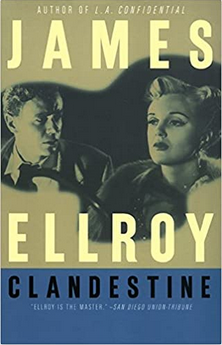
“I’m a take-me-as-l-am person, and all the rest is water under the bridge. You can’t change yesterday any more than you can predict what’s gonna happen tomorrow.”
–Glen Campbell
Recently, I watched the documentary film Echo in the Canyon, which triggered a chain reaction of reading and listening activity. On the listening level, it was a revisit to Pet Sounds by the Beach Boys and a few others. Arguably, one of the best albums of all time, and specifically, the song I Just Wasn’t Made For These Times strikes a chord for me. For the record, I think it’s a disgrace that Mike Love is touring under the Beach Boys moniker, sans Brian Wilson, but I do acknowledge that Mike’s contributions have been underrated. In addition, the amount of those contributions certainly can be up for debate, but at this point, I’m not sure it matters much. Having said all this, the book reading reaction to Echo was first to pick up yet another music biography. This time, I gravitated to the latest Neil Young book, Special Deluxe: A Memoir of Life and Cars. Likely, this will be written about in the future to add to my FR musician catalog of Tom Petty, Prince, the Wrecking Crew, and the disaster at Altamont involving the Rolling Stones. Arguably, the attraction to Neil was threefold: (1) the coverage of Buffalo Springfield in Echo; (2) the large absence of Neil from it; and (3) the iconic sideburns, which have remained constant over the years. Now, in the world of unique tidbits of one’s appearance, the sideburns are a difficult animal. The lamb chops could arguably have been unique at one point in time for many individuals (and they certainly are for a guy like Neil), but like most everything else in today’s world, are now over-done. In all seriousness, in order to really pull this off, you need the hairstyle to go with the burns, like this example. Note to self: Scour thrift stores for pastel leisure suit to go full tilt – this could be the originality that sets my appearance over the top. For more inspiration check out Queen’s Gambit for applicable ideas for any hip ladies and gents. For the cat writing this (me), the current COVID look is closer to John Quincy, minus the bald spots. Wa-wa.
Now, having decided to pass on writing about Neil, I picked up another period writer from a time which if I could teleport, I certainly would. So, as the “The Cowboy” from Mullholland Drive says, let’s get right down to it. That writer is James Ellroy and the book is Clandestine. When I say teleport, the time period seems cogent, but Ellroy’s portrait of L.A. certainly is bleak. Clandestine follows many of Ellroy’s other narratives, in this case LAPD cop Fred Underhill. The themes in Ellroy’s L.A. are similar: Murders of women, corrupt cops, hopheads, and other “degenerates.” This is familiar Ellroy territory, and anyone having read anything by him will feel right at home. It doesn’t make the mysteries (the book follows multiple murders) any less interesting, just the look and feel remain constant. There’s also the cross-pollination of some characters you may recognize from L.A. Confidential, such as the ruthless and crooked Lt and then Captain Dudley Smith. In actuality, Clandestine was Ellroy’s second work (after Brown’s Requiem), published in 1982. It’s easy to see his progression from Clandestine to his impeccable L.A. Quartet (The Black Dahlia, The Big Nowhere, L.A. Confidential, and White Jazz).
Now for a brief synopsis: In Clandestine, the story follows the main character, Fred Underhill, and his relationships. His relationship with the LAPD, with his partner, with Dudley Smith, his DA lover, and of course the victims and suspects. Clandestine describes the secret program run by Smith, to conduct investigations and interrogations as a part of secret program of LAPD cops, and has another hidden meaning. But this story is quite a bit more about the change that takes place among Fred Underhill, over a period of time as he investigates murders. This book isn’t Ellroy’s best work by any stretch of the imagination, and the territory has been covered in a more entertaining fashion in the L.A. Quartet. However, if you like his writing style and a decent mystery, you may find this book to be a good read.
Ellroy, James. Clandestine. Avon Books. 1982.
Friday Reads: B is for Beer

This book is described, appropriately, as a children’s book for grown-ups or a grown-up book for children. In addition to reading it myself, my 9 year old and my 13 year old also enjoyed it. The book, obviously, is about beer. It details the history and finer facts about beer, weaved into the story of young Gracie Perkel, a 6 year old living in the Pacific Northwest, namely, Seattle. Gracie becomes interested in the stuff her daddy and uncle Moe (who steals the show) drink, that looks like “pee-pee”. Robbins has a way of describing the mundane in a way that brings hilarity into the room. In this story, that is Gracie’s interactions with Moe (full time beer drinker, part-time philosopher), a visit from the Beer Fairy, and the condescending teetoaler Sunday school teacher (who’s breath transcends bad, having the potency to “paralyze a rattlesnake”). At any rate, the novel is a good mix of the plot story of Gracie’s life, the life of Moe, Gracie’s parents (mostly her mom), and the beer stuff.
Robbins suggests this is a good book for a grandpa to read to his grandkids, whilst cracking a “cold one”. It very well may be. At least it is an entertaining and quick read.
Robbins, T. B is for Beer Ecco, 2009.
How Much Do Libraries Benefit the Community?

Did you ever wonder what how valuable libraries are to communities? This week, let’s take a look at some of the basic services libraries provide, and imagine a community where a library (gasp!) doesn’t exist. What would residents have to pay for those services in the absence of the library? Well, those are hard numbers to come up with, as libraries often provide valuable programs and services that are difficult to quantify. However, we have tried, and came up with this summary for the entire state. Many thanks to my colleague, Allana Novotny, for all of her assistance.
To summarize this handout a bit, we looked at the total local government revenue, or cost to taxpayers, and it should be noted that the library data we used is from the most recent annual public library survey, fiscal year 2019. Next, we looked at the population of the service areas of public libraries within the state, which is a bit less than the overall population of Nebraska, because there are some areas that are unserved by a public library. This gave us an annual cost to each taxpayer of $41. Finally, we looked at the number of times that things in the library were used (e.g. books, electronic books, Audiobooks, computers, and Wi-Fi uses) and assigned a conservative value to those things. For instance, if someone didn’t have access to a book and had to purchase it on their own, what would they typically have to pay for it.
It should be noted (as the handout mentions on page 2) that in addition to the things itemized, libraries provide numerous other programs and services that are valuable but difficult to quantify. While the handout lists the number of programs offered and attendees in FY2019, page 2 also lists a number of other things that libraries often provide that are valuable to the community, such as meeting room use, printing services, fax services, homework help, outreach services, makerspace equipment, reference services, magazines, and newspapers.
